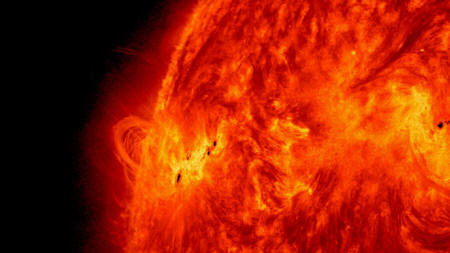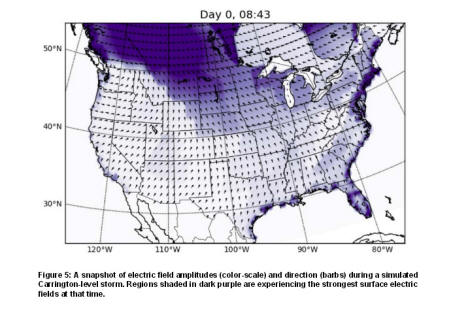|

June 07, 2013
from
RT
Website

image from
http://www.nasa.gov
A power outage could leave Western nations without electricity for
months in the event of a strong geomagnetic storm, a new report
claims, adding that it is “almost inevitable in the future” while
the sun is approaching the peak of its solar cycle.
It is a known fact that solar activity is interconnected with the
our planet’s geomagnetic fields that are known to affect life on
Earth, including widespread electrical disruptions.
Currently the
Sun’s activity is ramping up toward what is known as solar maximum
as the peak of the 11-year solar cycle is expected in 2015.
According to the report (Solar
Storm Risk to The North American Electric Grid), produced
by Lloyd’s in cooperation with
Atmospheric and Environmental research (AER), super solar storms
normally occur approximately every 150 years, the last being
the
Carrington Event in 1859 - a geomagnetic storm that caused
disruptions in telegraph lines all over the world and the brightest
auroras.
However that was long before people were so dependent on
electricity.
The report outlines a doomsday scenario - the cancellation of the
services the public has come to depend upon every day.
For example,
the systems for controlling air-traffic would stop, potentially
grounding entire fleets. The satellites that power the world's
telecoms networks would be knocked out.
Hospital patients dependent
on electrical equipment would be put at risk.

Aurora.Reuters /
Lehtikuva / Pekka Sakki
This could lead to liability claims if customers believe companies
did not take enough protective measures during a blackout, which
would have significant implications for the insurance industry.
Sunspots concentrate extreme magnetic activity on the sun's surface.
Magnetic field lines “looping out” of sunspot regions can reconnect
and release a large amount of energy, that can cause solar storms or
coronal mass ejections (CME).
During a CME the sun releases bursts
of plasma , intense magnetic fluctuations, that can reach Earth's
atmosphere. This material compresses the earth’s magnetic field. It
results in an increase of electric current in the atmosphere,
generates electromagnetic fields that induce ground electromagnetic
fields.
Large amounts of geomagnetically induced currents (GIC)
flowing through a power grid can damage power transformers and lead
to voltage collapse, resulting in power outages.
All this can occur as a result of strong geomagnetic storms - severe
disturbances in the upper layers of our atmosphere caused by solar
storms.
The geomagnetic storms induce currents in long conductors
such as power lines. These additional currents can trigger voltage
collapse or damage extra-high voltage transformers. The economic
costs would be catastrophic, according to the report.
The total cost of such a scenario today in Europe and North America
is estimated at $2.6 trillion for a five-month blackout period,
though it could be as low as $0.6 trillion, the Telegraph reports.
In 1859 a solar superstorm,
the so-called Carrington Event, hit
Earth's magnetosphere and induced the largest observed geomagnetic
solar storm, causing bright auroras that were seen around the world.
People who happened to be awake in northeastern US could reportedly
read a newspaper by the aurora's light. During the storm telegraph
wires in North America and Europe were reportedly destroyed, giving
operators electric shocks and knocking out the telegraph network as
far away as Australia and Asia for two days.
That was before modern
methods were used to calculate the force of the solar storms.
In March 1989, the strongest measured geomagnetic storm caused the
collapse of Hydro-Québec's electricity transmission system in
Canada. More than six million people lost electric power for nine
hours. That cost the government $12.7 billion.
Historical auroral records suggest a return period of 50 years for
storms like the one in Quebec and about 150 years for extreme storms
such as the Carrington Event.
The researchers mapped potential effects on the US territory of an
extreme solar storm much alike the Carrington Event in the report.

image from
www.lloyds.com
Geomagnetic latitude, ground conductivity and distance from the
coast’s highly conducive seawater can measure the region’s
susceptibility to geomagnetic storms.
For example such populated
regions as New York and Washington DC strongly attract the sun’s
electric energy. Other regions include the US Midwest and the Gulf
Coast states.
According to the data in the report the total US population at risk
of extended power outage from a Carrington-level storm is between
20-40 million, with durations of sixteen days to one or two years.
“The duration of outages will depend largely on the availability of
spare replacement transformers. If new transformers need to be
ordered, the lead-time is likely to be a minimum of five months,” it
says.
"They are very limited in terms of numbers of replacements and
manufacturing new transformers takes quite a long period of time, up
to almost two years” said Neil Smith, Research Manager at Lloyd's of
London as quoted by the Telegraph.
"These are huge pieces of
equipment. Building and transporting it is a huge job” he added. "This could take weeks, even years, in the event of a really
big storm.”
There are currently four satellites that can warn Earth of the
coming CME and allow grid operators to prepare and take preventative
measures before the storm, though the report adds that the force of
the storm can only be measured in 15-30 minutes before it hits.
The
satellites are also past their mission lives and need replacement.
However the cost of prevention is reportedly much smaller than the
price of damage caused by a single storm.
For example, after the
Quebec power outage the Canadian government has taken preventative
measures by investing $1.2 billion into protecting the Quebec grid
infrastructure, potentially saving billions of dollars if the
incident should occur again.
|



